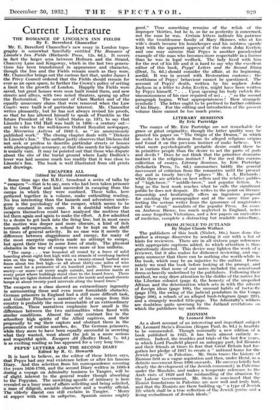Current Literature
THE ROMANCE OF LINCOLN'S INN FIELDS By E. Beresford Chancellor Mr. E. Bereiford Chancellor's new essay in tondOn topo- graphy is somewhat - fancifully entitled The Romance of Lincoln's Inn Fields (Richards Press, 12s. 6d.). It covers in fact -the larger area between Holborn and the Strand, Chancery. Lane and Kingsway, which in the last two genera- tions has been transformed in appearance and character, though the Inn and the Fields remain much as they were. Mr. Chancellor brings out the curious fact that, under James I the Privy Council ordered that the Fields should remain for ever as an open space, to further the Crown's policy of setting a limit to the growth of London. Happily the Fields were sated, but great houses were soon built round them, and new streets and alleys; with two noted theatres, sprang up after the Restoration. The account of Clare Market and of the equally unsavoury slums that were removed when the Law Courts were built is of particular interest. Mr. Chancellor writes pleasantly, but he has not always revised his proofs, so that he has allowed himself to speak of Franklin as the future President of the United States (p. 137), to say that Lincoln's Inn Old Hall was built in 1606—a century out— and to refer to the well-known Oxford Royalist newspaper, the Mercurius Aulicus of 1642-5, as " an anonymously published work." The closing chapter deals with " Dickens in Lincoln's Inn." The author justly observes that Dickens did not seek or profess to describe particular streets or houses with photographic accuracy, so that the search for his originals is usually vain. It may be pointed out that those who dispute about the site of the burial ground where Lady Dedlock's lover was laid assume much too readily that it was close to Lincoln's Inn. The book is well illustrated from old prints and drawings.






























 Previous page
Previous page